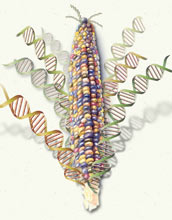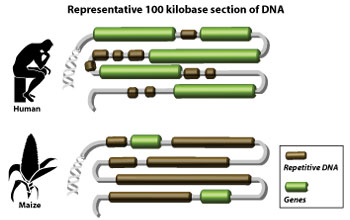All Images
News Release 05-197
NSF, USDA and DOE Award $32 Million to Sequence Corn Genome
This material is available primarily for archival purposes. Telephone numbers or other contact information may be out of date; please see current contact information at media contacts.

NSF, USDA and DOE have awarded $32 million to sequence the maize (corn) genome. Researchers for the maize genome sequencing project are from Washington University, Cold Spring Harbor Laboratory, Iowa State University, University of Arizona, University of California, Berkeley, the Department of Energy Joint Genome Institute, University of Georgia and Stanford University.
Credit: Nicolle Rager Fuller, National Science Foundation
Download the high-resolution JPG version of the image. (678 KB)
Use your mouse to right-click (Mac users may need to Ctrl-click) the link above and choose the option that will save the file or target to your computer.

In 2004, U.S. growers planted 81 million acres of corn for food, animal feed and inclusion in myriad food products. Corn is also an important material for many industrial purposes and products including rubber, plastics, fuel and clothing.
Credit: Nicolle Rager Fuller, National Science Foundation
Download the high-resolution JPG version of the image. (189 KB)
Use your mouse to right-click (Mac users may need to Ctrl-click) the link above and choose the option that will save the file or target to your computer.

DNA from the human and maize genomes contain dispersed arrangements of genes (green in maize.) The number and size of repeated DNA segments (brown) between the genes in maize present unique challenges for the sequencing team.
Credit: Nicolle Rager Fuller, National Science Foundation
Download the high-resolution JPG version of the image. (191 KB)
Use your mouse to right-click (Mac users may need to Ctrl-click) the link above and choose the option that will save the file or target to your computer.

To sequence the maize genome, scientist first collect and purify DNA from maize plants in the laboratory. Purified DNA is "chopped up" to produce DNA small enough to analyze. A sequencing machine determines the actual order of about 1,000 DNA bases (abbreviated G, A, T, or C) at a time. By analyzing the sequence data with sophisticated computers programs, the fragments can be aligned by overlapping their ends. Repeated sequences throughout the genome make it difficult to match up the correct pieces. When the project is completed, researchers will know the sequence of all 2.5 billion DNA bases in the maize genome.
Credit: Nicolle Rager Fuller, National Science Foundation
Download the high-resolution JPG version of the image. (253 KB)
Use your mouse to right-click (Mac users may need to Ctrl-click) the link above and choose the option that will save the file or target to your computer.


